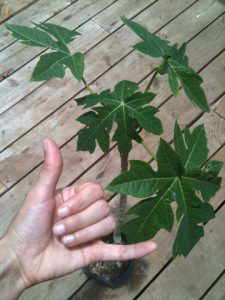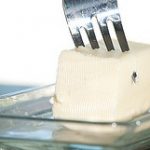
When I think of GMO foods, that is, crops which have been altered from their natural state by means of genetic engineering, there’s a short list that pops into my head — corn, soybeans, canola, cottonseed — the big boys, the brainchildren of Monsanto. They’re the crops that largely fall under their corporate control, in the 90% range and climbing. The ones you can be nearly certain you are consuming in their genetically-engineered form if anywhere on a product’s ingredient list you see their names appear.
In fact, if you’re any sort of a subscriber to Real Food, you know this is one of the main reasons to avoid the processed stuff, as they are highly contaminated with GMO ingredients.
But when it comes to real, fresh foods, there seems to be less of a concern. We know that organically-grown produce is a better choice than conventionally farmed produce, but this is largely in order to avoid chemical toxicity from pesticide and herbicide use — not so much for fear of the foods being GM. And of course, there are foods that pose less of a risk of toxic contamination than others, as our friends at the Environmental Working Group will advise us with the “Clean Fifteen” and the “Dirty Dozen.” So we don’t necessarily absolutely always have to make sure the produce is certifiably organic, it seems.
As for me, I try to buy my produce grown locally from farmers’ markets. And since I don’t generally find myself hankering for a slice of canola (what even IS that, anyway?) or a bud of cotton plant, and I KNOW to avoid soy (at least the unfermented variety, story for another day), that pretty much leaves me with corn to worry about, when it comes to GMOs. I try to buy my cobs of corn from small farmers that I can ask personally whether or not it’s organic, and not born of Monsanto seed.
So is that it, then? Are there any other fresh foods, especially those to be found in my Hawaiian islands, that could potentially be genetically engineered?
Yup.
In researching which foods to watch out for that could potentially be tainted by genetic engineering, I came across a current list slightly longer than my aforementioned short one, and began assessing it:
Corn — Yeah, I knew that.
Cottonseed — Right, used in hydrogenated oils.
Canola — Uh-huh, that too.
Soy — Yeah…GE is the least of your problems, Soybean. Blech!
Sugar, from Sugar Beets — Well, I pretty much try not to eat you, too.
Certain Varieties of Zucchini — Hmm, okay…
Crookneck Squash — Uh, I don’t even know what thats is.
…
HAWAIIAN PAPAYA [dramatic emphasis mine] — ARE YOU FREAKING KIDDING ME?!?
Why??
How did this happen? What purpose does screwing around with the genes of our precious little papaya serve to warrant such irreverence for this very valued crop of ours? (Papayas are a multimillion dollar industry here, and Hawaii is the only place where they are still commercially grown — it’s important to us!)
Well it turns out, they did kind of have a good reason.
In the 1990’s, a very serious crop disease called the ringspot virus permeated the papaya crops to the point where the business — and the fruit itself — was nearly wiped out, with over a 40% decline in production. Farmers were going out of business, the virus epidemic was ever increasing, and folks were getting pretty worried.
So in 1998, scientists at the University of Hawaii stepped up with what they felt was a good solution. They identified and cloned a gene within the protein of the virus, then inserted it into the fruit, creating resistance — similar to the way a vaccine can create immunity (um…that one sounded off some alarm bells for ME…anyone else?).
This new breed was dubbed, the “SunUp Papaya.” and was then bred with the standard papaya to create the “Rainbow Papaya.” Cute, huh? And thus, the papaya became genetically engineered, complete with a manhandled, unnatural hybrid form, no less.
The plan to rescue the fruit from near extinction was a success. Within a few years, business had bounced back up to normal, and the industry as a whole was saved. But the integrity of the natural papaya, was not.
And — surprise, surprise! — somewhere along the line, Monsanto got their grimy little hands on the patent for the virus-protected papaya. So with that, came their rights to slap a lawsuit on anyone whose organic farms dared to be downwind of the GMO variety, causing cross-contamination of the patent-protected papaya. All other issues aside, this is not something that we ought to support.
A Cause for Concern
Despite claims by the Hawaiian Papaya Industry Association (bias, anyone?), that GMO papayas are perfectly safe for both human consumption and the environment, there is already evidence to suggest that the papaya ringspot virus coat protein (the gene from which is inserted into the GE papaya for vaccine-like resistance) is a “potential” allergen because it contains a string of amino acids identical to a known allergen.
In addition to the risk of unexpected allergic reactions, potential hazards to our health from GE papayas (and other GMOs) include increased antibiotic resistance, which contributes to the risk of superbugs, or antibiotic-resistant disease.
Unfortunately, further scientific evidence pointing to these potential hazards of GMOs is hard to come by. The biggest problem with the claims of GMO safety (coming from those who are trying to sell it to us, in bed with the FDA) is that there really isn’t any proof. It seems to be more of a, “Well, so-far, so-good!” attitude, and I don’t know about you, but I don’t want to be a test subject in this new and potentially dangerous experiment.
Widespread contamination from GE to organic papaya is becoming a huge problem in Hawaii, with many farmers unintentionally ending up with GM seeds either by cross-pollination or by purchased seeds from the University of Hawaii. The papaya population as a whole is now over 50% GMO, with small percentages of contamination being found even on organic farms. Developers are now being pushed to scrutinize the purity of the “organic” seeds they are selling to the community, and turn to other agricultural advances to fend off problems like the ringspot virus, without resorting to genetic engineering.
Dr. Lorrin Pang, MD, MPH, a public health specialist, explains that the GMO contamination crisis needs immediate action taken to rectify it.
“All of these concerns [of GMO health risks to humans] are troubling in themselves, but they would be less worrisome if the GMO mutations did not spread beyond our intentions. [Today’s] report shows that they do. If a health problem arises that is attributable to GMO foods, it will be impossible to recall such a live, dangerous mutation once it has been released into the environment,” (from the Northwest Resistance to Genetic Engineering).
Scary stuff.
What Can We Do?
Is the solution to just never buy papaya again, then — just in case? If you’re concerned enough to go that route, of course that would be the best fool-proof way to never again swallow a bite of a GE papaya. But as for me, I don’t plan on cutting out this favorite fruit of mine any time soon.
If you buy your fruits from farmers’ markets, chances are you probably won’t find any locally-grown papaya on the mainland. Since that leaves you with shopping at the store, thankfully there are some good tactics you can use to avoid the GM variety.
First, you definitely want to pass any papaya specifically labeled “Rainbow,” “Sunrise,” or “Strawberry” papayas, as these are all names of hybrid fruits bred with the original GMO variety.
 A true, non-GE papaya has a rich, deeply yellow flesh — not golden or even pink like the hybrids. The real deal is called the “Kapoho” or “Kapoho Solo” papaya, so look for this name if you can.
A true, non-GE papaya has a rich, deeply yellow flesh — not golden or even pink like the hybrids. The real deal is called the “Kapoho” or “Kapoho Solo” papaya, so look for this name if you can.
Another good strategy is to take a look at those little sticker labels on your papaya. They will contain a PLU code, or number, that will indicate how the fruit was grown:
- Conventionally grown: Four numbers, for example — “1034”
- Organically grown: Five numbers, starting with the number 9 — “90123”
- Genetically Modified: Five numbers, starting with the number 8 — “80123”
Pretty slick trick, no?
Since anything labeled USDA Organic cannot be GMO by law, we’re obviously going to be aiming for organic papaya, as that’s a pretty safe bet. Organic growers will frequently test their crops in an attempt to weed out the problem papayas caused by GE cross-contamination.
Oh, and if you do find yourself needing an organic papaya while in Hawaii, come find me! This little guy may have a fruit or two for you soon…
{This post is participating in Fight Back Friday at Food Renegade, Monday Mania at the Healthy Home Economist and Real Food Wednesday at Kelly the Kitchen Kop!}






Thanks for posting this. I look at papayas in the store and move on, not knowing which might be GM. I wonder if they’ve gotten to the papayas from Mexico yet??? That’s closer to us and I’m seeing more and more fruit from Mexico. I know papaya is great for you (and good for your stomach is what I always heard growing up) and I would like to incorporate it into our lives more.
Thanks for the info!
Ugh, we get Mexican MANGOS here which drives me absolutely crazy!! Why are we shipping them over from thousands of miles away, when local farmers that grow them right here need our business? So sad. I’m not sure about papayas from Mexico, though my guess is that they are probably fairly contaminated with GM and are unlikely to be organic. I would just stick with USDA organic papayas from HI. Oh and you heard right, by the way — papayas have great natural enzymes that are good for the tummy! 🙂 Thanks for stopping by, Beth!
Interesting…we were in Oahu recently (in May), and while shopping at Whole Foods I was given a sample of strawberry papaya, had no idea it was GMO. I don’t think that papaya is one of my favorite fruits, just don’t love the texture I guess, but I would think that Whole Foods would do a better job of monitering that. Otherwise, I was really impressed at the selection they had of local produce and products.
We were staying at the Marriott on the west side, and when we needed to stock up on groceries again, we ended up at Safeway, and after a few minutes there, I decided to just make the drive back to Honolulu to Whole Foods, even though it was so much further away-it was so discouraging to walk into the produce section of Safeway and not see one local product. I went by the fish counter, and even the mahi-mahi was from Peru or somewhere way far away. We did manage to find an awesome farm stand while driving along the North Shore and managed to stock up on lots of goodies. I ate more fruit in Hawaii than I have in a while-you guys have such amazing produce! Just wish the local grocery stores (like Safeway) carried more of it, such a shame!
I could not agree more!! Safeway just doesn’t do squat to support local businesses and local ag around here… I kinda started boycotting them. Mahi from Peru, how ridiculous! And shame on the Whole Foods, they ought to know better! You know what’s funny? I have never once set foot in the store. I’ve never lived anywhere near it, and like you said, farm stands and markets up here on north shore are worlds better! Who wants to pay “eighty bucks for six things” anyway… http://www.youtube.com/watch?v=2UFc1pr2yUU <-- (Have you seen this? Lol!)
I saw your link to this article on Fight Back Friday and had to check it out! There’s a lot of good info here.
I don’t know anything about Oahu, but I thought I should add that most Big Island farmer’s markets do sell non-GMO papaya, and it’s often cheaper than strawberry papaya. The one in Hilo does for sure, and I’ve seen non-GMO papaya at the Volcano farmer’s market as well. Our local grocery chain (KTA) also sells non-GMO produce, and a lot of their produce (and eggs/meat!) are island-grown (and grass-fed!). One of the little perks of living on the B.I., I suppose.
Aloha Nicole! Oh you totally do have a lot of perks living on big island! I’d add to that list that you can also fairly easily obtain raw dairy as the “underground” over there is pretty big, from what I hear. Pretty jealous of that! And yeah, at markets here, I’ve definitely seen GM papayas, and you definitely still have to ask to be sure. Even with corn and stuff. Kinda sad. Well, thanks so much for stopping by and reading! So cool to find another real foodie from HI! 🙂
I just took a class and they mentioned not eating ANY Hawaiian papayas. That freaked me out because we eat them every morning. I asked our Farmers Market guy what kind he had and he said the Reds were GMOs. But the ones from Kahuku were OK. I think he said it was called Yellow. I’m starting to feel paranoid here.
By the way, I added a link to your blog from mine. 🙂
Thanks Emily!
Crazy, isn’t it??
So hard to *know* what’s real food, & what’s not! I’ve only been to Hawaii once, & when we visited a little Natural food store, got as many things that were local as I felt I could eat in the few days trip – then at Safeway, watched my friends buy the fruit they were *used to* (I think bananas, but maybe even apples!) while I got some unfamiliar ones, & asked the clerk about how to eat ….
I do look for OG listing, & have a CSA share so get good OG veggies (& grow many myself) ….
GMO alfalfa is one of our mainland concerns these days – since it’s big & shades out competition (‘weeds’) no need to spray herbicide on the old crops … now Monsanto will have a new market for Round-up 🙁
So crazy. Yeah the GM alfalfa is seriously bad news. Unfortunately, I don’t know that there’s much left to be done about it at this point. Growing your own stuff is a great way to get around the whole Monsantofied food supply though! Good for you. Thanks for your comment, Dia!
I’ve lived on the BigIsland from the mid-70’s and was eating strawberry papayas then. Gmo at that time,? I don’t think so. Any ideas as to when, if all this new info about strawberry papayas being gmo, as to “when” strawberry papayas went gmo?
Let’s make sure correct info is out there.
I’m on Kauai now with my husband for vacation. I’d love a suggestion on where to get org. papayas. Most of the ones I’ve seen don’t even have labels, I’m not sure where they’ve come from or how they’re grown. Thanks for any suggestions
I lived on Oahu and I actually never went to Kauai, so I don’t know where a good place to send you is to find organic papayas. But your best bet is probably to just ask. If you’re looking at fruit stands or markets, the people selling them should know. Ask if they are the “solo” or “kapoho” kind. If they’re in a grocery store, check the sticker label using the trick with the numbers I mentioned. Hope you enjoy your vacation!
Thank you for this. I eat a half papaya every day, just about, for breakfast with my eggies. I can’t always find (or afford) the organic ones. I will make sure to go organic or 4 digit conventional. THANKS. My mom had a papaya tree, and one day, I may just plant my own organic one. I ain’t giving up my fave breakfast fruit.
Ooh, having papaya trees would be awesome if they can grow where you live! Now that I’m an Oregonian, that won’t be the case for me. 🙂 But I still love papayas, too! Thanks for your comment!
i think you can grow papaya there from seed, if you start indoors very early. they are a quick, first year fruiter. i’m trying it in maine this year, but i already started too late, probably, but i will get a good idea of how it will work. look it up…
Just bought a papaya, but didn’t realize it’s called “strawberry sunrise” with a PLU # of 3111. Pretty sure it’s gmo!
Pretty sure you’re right. Ugh… I’m not sure how reliable the sticker trick is with papayas. I’ve heard of them being mislabeled before. Frustrating. :-/ See if you can find the “solo” variety, and try to stick with that.
I love strawberry papayas…but I knew from day one (my first visit to the islands) that they are GMO. I ate them anyway. My quest to live a non-GMO life and practice what I preach, I’ve given up a lot of stuff…including eating out at my favorite restaurants.
Great article…I’m sending it to my friends. I think getting the awareness out there about foods we don’t think about much on the mainland will raise more eyebrows. Even though your wrote it last year, not much has changed.
What allergy does this known allergen provoke? Is the string of amino acids the whole allergen protein or just part of it? Is this string spelling, “SUPER”, as in, “SUPERBUG”, or as in, “SUPERFICIAL” ?
How does engineered resistance to a plant virus risk antibiotic resistance in bacteria (your, “superbugs”), especially since antibiotics are ineffective against viruses in the first place and this GE papaya doesn’t produce any antibiotics?
As far as patents are concerned, they last 20 years. This GE papaya was first used in 1999. Now is 2012. 7 more years and it’s public domain.
If i were these vandals, i would be very careful. A lot of farmers are pro NRA.
In your article you state ALL strawberry papaya come from GMO seeds. This is NOT true. The GMO papayas are Rainbow and Sun Up. Please CHECK YOUR FACTS before scaring away people and harming good farmers like those at, Kumu Farms. They grow some of the only “NON GMO” papaya in Hawaii and they are Sunrise and Strawberry. Help sustainability and farmers trying to grow NON GMO fruits and vegetables.
Please visit their website or take a tour while in the islands….. Aloha
Thanks, but, I lived in Hawaii for years. I’ve been to many farms. Check my facts yourself by looking at the sources for my statements. Coming straight from the Hawaii Papaya Industry Association.
“Sunrise/SunUp – Popular by its nickname “strawberry” papaya, Sunrise has a freckled greenish-yellow skin that turns yellow as the fruit ripens, but inside is a juicy, dramatic red-orange color flesh. SunUp is the genetically engineered papaya of the red-flesh variety that is resistant to the ringspot virus disease.”
Hawaii Papaya Industry Association
Doesn’t make much sense for them to shoot themselves in the foot with claims that these types of papayas are GM if they aren’t absolutely sure.
Look, I know most people aren’t intentionally trying to grow GM seeds. I’ve had several angry farmers come at me accusing me of spreading “lies” (your name sounds familiar, pretty sure you are one of the ones who emailed me) yet won’t accept the fact that I am only quoting information straight from the mouth of their own industry leaders. Grow Kapoho/Solo papayas if you want to avoid GMOs. Sadly, that’s the only one of the four that isn’t GM. It’s not the farmers’ fault, I certainly don’t blame them, but that’s the way things are today.
We are on Maui – Manna’s organic food store in Paia (the best!) carries two kinds of papaya – my favorite is a “strawberry” papaya from Molokai, its label says no GMO, organic — yet carries the code #3111
In Napili on teh other side of the island, there are Domingo “strawberry” papaya – no product code – but there is a phone number (808) 937-7582
I work in pricing at a supermarket. It is doubtful you will ever really see a tag with an 8 in front on GMO produce. It is possible but only if the plantation tags their own. Otherwise tags are put on at the store just so the product will ring right at the register and the produce clerk would not know to put an 8 in front.
Case in point is sweet corn. Most local sweet corn sold in supermarkets in summer is GMO (Bt corn). It isn’t usually tagged at all because a checkout girl can see it is corn and knows the PLU. The produce manager probably would only know if it is organic or not and not be able to say anything about it being GMO (Bt corn or Roundup ready field corn). They could give the farm name if it was locally grown in summer. It is much more prevalent to find GMO food in the grocery aisles not produce dept.
Thanks, Tamara. I wondered how often you would actually see the number with an 8. There aren’t many GMO fresh crops, anyway. Like you said, they’re much more prevalent in prepared/processed foods. I think my source for that info was more saying that if you do see an 8, it’s GMO, but not necessarily that if you don’t see it, that it’s not. For papayas and corn, it’s a better idea to just look for organic, or for papayas, the kapoho solo variety.
Mahalo for the helpful info!! I live on Kaua’i and get my papayas from Farmers Markets and I’ve been wondering about this for a long time!
I came across this article today, so I know this is a bit of a late post, but I just wanted to get this out there. The fact of the matter is, without this “GMO” papaya, papaya production would no longer exist. Period. Maybe you could grow a tree in your backyard, but the days of purchasing it in the store would be over. You alluded to Papaya ringspot virus in the article, but you kind of undermined the significance of the disease. Without the genetically resistant papayas, this disease would have completely wiped out the industry. The only reason organic papayas (i.e., non-transgenic) can even be grown today is because so much of the acreage is now planted with resistant papaya. This essentially disrupts the spread of the disease enough to allow for small scale production of susceptible varieties. Another important point is that not all GMO’s are created equal. This isn’t like RoundUp resistance with a gene from a microbe being used in a plant. This is designing a plant that will express its natural response to virus infection before it is infected. This allows it to prevent the disease from becoming systemic. An organic variety would produce the exact same response, it would just do it too late to save the tree. Finally, saying this could in any way lead to antibiotic resistance is absolutely ridiculous and flat out misleading. This is a virus we are talking about. Antibiotics are used for bacterial diseases. These issues have nothing to do with each other. Stop trying to scare people over nothing.
Having read the article and comments above,I am totally confused as to whether there were strawberry papayas in existence before the GMO variety was introduced. I live in Costa Rica, where papayas can be found in many yards. The flesh of these comes in a range of colors from yellow-orange to pink. As these are easily grown from seed, it is possible that even these backyard plants/trees are cross-bred with GMO papayas (I have been told here that Hawaiian papayas are better than the local ones, so there are plenty of the Hawaiians in the markets). Now I wonder about the seedlings I have growing in my yard, some of which are blossoming right now for the first time.
I came across a papaya at our local farmer’s market with a label “Kahuku Brand”. Is that non-GMO? I hope so. I can’t seem to locate any Kapoho papaya.
The papayas grown by Fruta Bomba, a division of Brooks Tropicals of Florida, in Belize are “RoundUP Ready”. They are saturated with insecticides and herbicides. I live across from papaya fields and see how often they spray. Of course, they will say that they are only hybrid plants. I can read the labels on the barrels of chemicals they use, many of the local workers can not.
Thank you for writing this article, and what to look for when shopping. Very helpful!! I posted on fb.
Kristen Lauter
Holistic Healers Academy
i grow my own Papaya here in New Orleans.
while i have had several different varieties, the Maradol (mexican) papaya seem to do best in the cool
(sometimes freezing) winters.
You can buy Papaya seed from University of Hawaii
its like $1 a pack (NON_GMO)
you can buy the Rainbow (GMO) for $3
they have other veggies cheap as well…
not sure why its triple the cost, i want the Non-Gmo anyway
LINK provided
“Strawberry” is a papaya marketing term for pink or red fleshed papaya. It could be GM or not. “Sunrise” and “Sunset” are pink fleshed solo non_GMO. “Sun Up” is a GMO version of “Sunrise” and “Rainbow” is a GMO hybred of “Kapoho”(yellow) and “Sun Up”.”Solo” is a marketing term for small, single serving papayas, and often refers to Kapoho variety fruit.
The article linked to re:Patents states that Mnsnto recieved a patent for the viral insertion technique and donated rights to several universites. I don’t know who owns the Rainbow patent, but the seeds of most of the above papayas are available quite reasonably from UH ( http://www.ctahr.hawaii.edu/seed/seeds.asp ). You have to take an orientation before buying GMO seeds.
Many varieties of solo papayas are available at the “farmers'” markets from 6/$1 to 75 cents each. They are all delicious and nutricious. Enjoy!
Thank you for clearing up that confusion- should have finished reading the thread before posting. Sounds like my Whole Foods variety is GMO free.
I want to start an organic non gmo small plot of papayas, can you direct me to a place that sells non gmo papaya seeds and do the non gmo papayas self pollinate? I live in central florida..
thank you
Thanks for posting this. I’m trying to avoid GMO foods. I bought a papaya the other day at Safeway, came home, and starting reading some articles about GMOs, and listed in the article were papayas. Some papayas are GMO and other varieties aren’t. This was a strawberry papaya and it was nice to see an article about this specifically. 3 bucks for that thing.
I read your article on papayas. I remember eating Strawberry Papayas before GMO’s were introduced in the food industry. In the early to mid-80’s, the University of Hawaii produced “X-77” Solo papayas, which was supposed to be resistant to certain disease, but it’s texture was like wax. I do believe it was the one of the first GMO strains. Some farmers experimented and X-77’s were inter-planted with other strains of papaya, like strawberry and solo papayas. This type of planting caused slight cross breeding and did slow the spreading of diseases. Some of this cross breeding from inter-planting created the Rainbow papaya. I really enjoyed reading your article on papayas, since I was raised on papaya and always wonder if this fruit will ever become extinct… Thanks for the great information.
Regarding your statement “First, you definitely want to pass any papaya specifically labeled “Rainbow,” “Sunrise,” or “Strawberry” papayas”
It should be corrected.
Kamu Farms probably grows the only certified organic Hawaiian papayas on Moloka’i. The variety that they grow is the “Strawberry Sunrise” Papaya. Since their papaya is certified organic it obviously can NOT Be a GMO variety as there is no such thing as a certified organic GMO papaya, as we all know.
The papaya industry, in my opinion has gone out of there way to purposely confuse and mislead the public in a way that makes it more difficult to know which is GMO and which is not.
Thank You David Walker for the clarification:
I have simplified and summarized what you said below with the addition of the KUMU Farms certified organic “Strawberry Sunrise Papaya”.
“Strawberry” is a papaya marketing term for pink or red fleshed papaya. It could be GMO or it could be non-GMO.
”Solo” is a marketing term for small, single serving papayas, and often refers to the “Kapoho Yellow Variety Papaya”.
Non-GMO Papayas
“Kapoho Yellow Variety Papayas” are non-GMO.
“Sunrise Papayas” are pink fleshed non-GMO “Kapoho Solo Papayas”.
“Strawberry Sunrise Papayas” from Kamu Farms are pink fleshed non-GMO Organic Papayas.
“Sunset Papayas” are pink fleshed non-GMO “Kapoho Solo Papayas”.
GMO Papayas
“Sun-Up” is a GMO version of the “Sunrise Non-GMO Papaya”
“Rainbow” is a GMO hybred of the “Kapoho Solo Non-GMO Yellow Papaya” and the “Sun-Up GMO Papaya”.
Regarding your comment:
“Another good strategy is to take a look at those little sticker labels on your papaya. They will contain a PLU code, or number, that will indicate how the fruit was grown:
Conventionally grown: Four numbers, for example “1034”
Organically grown: Five numbers, starting with the number 9 “90123”
Genetically Modified: Five numbers, starting with the number 8 “80123”
I thought this was worth checking into further since I’ve always known about the organic designation but never heard of the one for GMO produce.
After talking to three produce departments at Whole Foods Market I was told that they do have GMO produce but it’s never marked as such. Instead it is hidden under the conventional four digit PLU number. As I thought you would be hard pressed to find the five digit PLU code for GMO starting with a “8” which they confirmed tha thye have never seen one. Take corn for instance, it is always marketed as conventional. Never have I seen a sign next to the corn that says “GMO Corn”.
International bestselling author, filmmaker and executive director of the Institute for Responsible Technology, Jeffrey Smith, says, “The great news is that there are only 4 GMO veggies or fruits at this point: papaya, but only from Hawaii and no where else; some zucchini and yellow squash, and corn. For these, unless it says organic or boasts a non-GMO sign in the store, eating them is a gamble. It could be GMO.” You can also add sugar beets, alfalfa and soybeans to the list.
It’s important to become familiar with the most common genetically modified foodstuffs, as well as the product derivatives that are most likely to be genetically modified, since there are a lot of differing opinions about relying on PLU codes. Some say that PLUs can be your secret savvy-shopper weapon, while others, like Jeffrey, say that GMO codes are “hypothetical” and not designed to communicate with customers since they are optional for retailers to use.
Since PLUs are currently optional to use, and especially since many Americans are afraid of genetically modified foods, retailers, and even some seed suppliers when selling to farmers, opt out of using the identifying numbers.
The bottom line usually wins out over concern for the health of the people. There’s not a lot of money to be made on a planet full of healthy, informed people. And there is plenty of money to cover up the issues caused by producers of genetically modified product as well as advertise its unfounded benefits. Companies like Monsanto have approximately $754 million dollars a year just for advertising. Wonder what the ad budget is for organic farming?